Article by Vanessa Monteleone
The GeoPRISMS (Geodynamic Processes of Rifting and Subducting Margins) Theoretical and Experimental Institute (TEI) organised a three-day workshop (8th – 10th February 2017) on the thematic of Rifting Initiation and Evolution (RIE) in Albuquerque, New Mexico, USA. The aim was to summarise progress and recent scientific advances related to the RIE initiative, and to identify high-priority science for future GeoPRISMS RIE efforts. The event included the participation of students and postdocs, which presented their research topics and progresses. The location for this meeting on continental rifting processes was anything but casual; in fact, the city of Albuquerque sits on the Rio Grande Rift, a case study on which we had an interesting overview by Karl Karlstrom and Laura Crossey (UNM) during the workshop. A field trip along the Rio Grande Rift was also organised on the Saturday following the meeting.
Demian Saffer (PSU), Tobias Fisher (UNM), Jennifer Wade (NSF) and Donna Shillington (LDEO) chaired the meeting during the three days, and a series of talks highlighted the recent research efforts on topics like “Rift evolution from initiation to post rift architecture”, “Magmatism, volcanism and volatile exchanges”, “Faulting and Strain”, “Surface processes” and “Hazards at rift and rifted margins”, showing cases studies from rift basins worldwide. A series of sessions were dedicated to identifying “Science gaps and priorities” during the three days, giving plenty of time for interactive group discussion.
As a new PhD student (I started in October 2016), the opportunity of getting involved in the RIE initiative at the onset of my research experience represented a fantastic way to approach the academic environment and to get a clearer idea about the progresses done by the research in studying the rifted continental margins. During the Student & Postdoc Symposium, organised the day before the workshop, and during the three days of the workshop, plenty of time was left for the poster session. I had the possibility to present my research topic (I am studying the rift evolution of the Eastern Black Sea Basin) in a dynamic but also friendly and relaxed environment, where people with different levels of experience, academic background and from different institutions have been able to discuss and share ideas related to their own and other’s work. It was very useful for me to talk to this group of people, creating contacts and probable future cooperation, as well as getting suggestions and opinions from professors and other students.
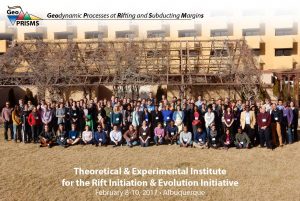
Following the workshop, GeoPRISMS organised a field trip to Kasha-Katuwe Tent Rocks National Monument (just one hour drive north of Albuquerque) in the Jemez Volcanic field, to look at pyroclastic deposits and to get an overview of the Rio Grande Rift. The Rio Grande Rift is a Late Cenozoic continental rift which extends from Colorado, USA, on the north to the state of Chihuahua, Mexico, on the south, dividing the Colorado Plateau on the west from the interior of the North American craton on the east (see map below). It is named for the Rio Grande, the major river that flows through most of its extent. Within the upper crust, the rift is characterised by a series of interconnected structural basins filled with thick accumulations of clastic sediments and local interbedded basalt flows. Several late Cenozoic volcanic fields are associated with the rift. The field trip explored an obvious E-NE alignment of late Cenozoic volcanic field, known as the Jemez lineament, which crosses the rift between the Espanola and San Luis Basin.
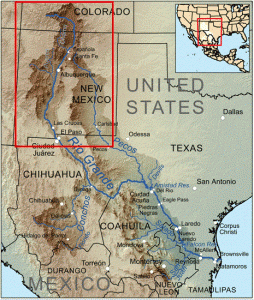
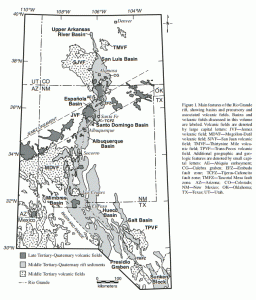
The field trip leaders, Prof. Karl Karlstrom, Dr. Laura Crossey and Prof. Tobias Fisher, all from the University of New Mexico, did a fantastic job in leading us and explaining the geological evolution of the Rio Grande Rift. We started the hike from 5,500 feet, through the gullies and canyons of the Tent Rocks, up to the top of the Kasha-Katuwe, at 6,700 feet.
The area owes its remarkable geology to layers of volcanic rock and ash deposited by pyroclastic flow from volcanic explosions within the Jemez Volcanic Field that occurred 6 to 7 million years ago.
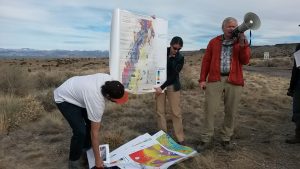
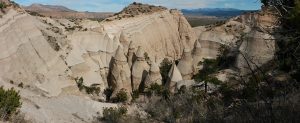
Thanks to the GeoPRISMS initiative I had the possibility to approach with new eyes the research world and to get an enthusiastic and fresh start for my PhD experience. Furthermore, it represented also a fantastic opportunity to briefly experience a new amazing place and a different culture.
For further information on GeoPRISMS: http://geoprisms.org/ and http://geoprisms.org/tei-rie-2017/
Suggested reading on the Rio Grande Rift:
Hudson, M. R. and Grauch, V. J. S. (2013), Introduction, The Geological Society of America, Special Paper, 494.
